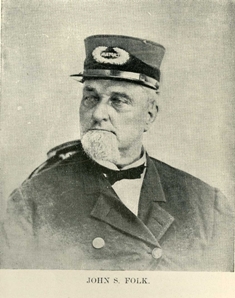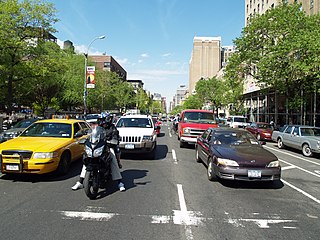
The New York City draft riots, known at the time as Draft Week, were violent disturbances in Lower Manhattan, widely regarded as the culmination of white working-class discontent with new laws passed by Congress that year to draft men to fight in the ongoing American Civil War. The riots remain the largest civil and racially-charged insurrection in American history.

The Plug Uglies were an American Nativist criminal street gang, sometimes referred to loosely as a political club, that operated in the west side of Baltimore, Maryland, from 1854 to 1865. The Plug Uglies gang name came from the enormous oversized plug hats they stuffed with wool and leather, pulling them down over their ears for head protection as primitive helmets when going into gang battles. Also, the term plug ugly was used to identify an extremely tough ferocious fighter who could give a sound beating to an opponent. The name Plug Uglies was used to refer to a number of criminal gangs in New York City as well as Philadelphia.
Henry F. O'Brien was the colonel of the 11th New York Volunteer Infantry Regiment who was killed during the New York City draft riots in 1863.
Edward E. Jardine was an American U.S. Army officer during the American Civil War serving with the 9th New York Volunteer Infantry Regiment under General Benjamin Butler and later the Army of the Potomac under General Ambrose Burnside in Virginia and North Carolina campaigns. He was one of the senior military officers during the New York Draft Riots and narrowly escaped lynching at the hands of a mob. The injuries he sustained during the riots ended his military career.
John G. Bergen was an American public servant and New York City Police Commissioner. A member and treasurer of the Board of Police Commissioners, he and Thomas Coxon Acton assumed command of the NYPD during the New York Draft Riots after Superintendent John Kennedy was injured at the hands of a mob.
Francis J. Banfield was an American soldier, law enforcement officer, police sergeant and founding member of the New York City Police Department "Steamboat Squad". Born in England, he emigrated to the United States as a child. He worked as a painter in his youth and later served in the Mexican-American War. He lived in California for a time before returning the New York to join the police force in June 1857.
John Cameron was an American law enforcement officer and police captain with the New York City Police Department. Although best remembered for his performance during the New York Draft Riots, Cameron was one of the most prominent senior police officials during the post-American Civil War era and the oldest serving police officer at the time of his death in 1873.

Anthony J. Allaire was an American firefighter, drillmaster, and military and law enforcement officer. A longtime police inspector for the New York City Police Department, he was responsible for the breakup of numerous street gangs, most notably the Slaughter House Gang and the Dutch Mob, as well as the capture of murderer Daniel McFarland in 1869.
James Z. Bogart was an American law enforcement officer and police captain with the New York City Police Department. A member of the old Municipal police force, he joined the Metropolitan Police Department upon its formation in 1857. From his official appointment on April 23, 1857, Bogart rose from roundsman, to sergeant and finally captain within only a few years. He served in a number of important posts throughout the city, including the Twelfth, Twenty-Second and Thirty-First Precincts.

Theron S. Copeland was an American law enforcement officer and police captain with the New York City Police Department. He studied military tactics at a military academy and in the National Guard before joining the police force in 1855. Much of his career was spent as a drillmaster and, during the New York Draft Riots in 1863, he was part of the force under Inspector Daniel C. Carpenter who confronted a mob intending to loot the New York financial district and the United States sub-treasury. Copeland was later named in a general address to the police force for displaying "valor and intelligent service" during the riots.
John F. Dickson was an American public servant, law enforcement officer and police captain with the New York City Police Department. He and drillmaster Theron S. Copeland led a police squad during the New York Draft Riots which were dispatched against rioters attacking African-Americans. He was also the longtime head of the Tombs Police Court and one of the oldest serving police officers on the police force at the time of his death in 1880.

John Decker was an American businessman, politician and firefighter. He served as the last Chief Engineer of the old New York City Fire Department, the original colonial-era volunteer firefighters of New York City, from 1860 until 1865. He led the fire department during the New York Draft Riots, for which he gained national attention, and later founded the Volunteer Fireman's Association.

Charles McDonnell was an American law enforcement officer and police captain in the New York City Police Department. Popularly known as "Lightning Charlie", he was responsible for a number of high-profile arrests during the 1870s/80s, including those of procuress Jane the Grabber and gambler Samuel S. Brewster.
Daniel C. Carpenter was an American law enforcement officer and police inspector of the New York Police Department. He was one of earliest leading detectives on the police force during the mid-19th century and also had a prominent role in the Police Riot of 1857 and New York Draft Riots in 1863. His successful defeat of the rioters was the largest, and perhaps most crucial, battle during the riot. Fought in front of the Metropolitan Police headquarters, Carpenter's victory saved the New York financial district from falling into the hands of the rioters.
Francis C. Speight was an American law enforcement officer and police inspector for the New York City Police Department. A noted crimefighter, credited for running out the criminal elements from Manhattan's Eighteenth and Nineteenth Wards in the 1850s, he also took part in the Police Riot of 1857 and New York Draft Riots of 1863. Prior to the outbreak of violence at the Third Avenue draft office, Speight was the only officer to maintain control of his station, the Broadway draft office, during the early hours of the riots.
Thomas Woolsey Thorne was an American law enforcement officer and police inspector for the New York City Police Department. He is credited for breaking up the Daybreak Boys, a gang of river pirates active along the New York waterfront during the 1850s, by closing their dive bar headquarters in Slaughter House Point. He is also one of the commanding officers during the Draft Riots of 1863, in charge of the City Hall Police, and helped defend the New York Tribune.

John S. Folk was an American law enforcement officer in New York City during mid-to late 19th century. A prominent police official during the early years of the Municipal Police Department, Folk served as the first police chief of the Brooklyn Municipal Police from 1851 to 1865, NYPD police inspector until 1870 and police superintendent from 1873 to 1875. He was also a participant in the Bread Riot of 1837, the Angel Gabriel riot of 1854 and the Draft Riot of 1863, helping defend both the offices of the New York Tribune and the Brooklyn Eagle from rioters.
George W. Dilks was an American law enforcement officer and police inspector with the New York City Police Department during the mid-to late 19th century. He was a prominent police official during the early years of the Metropolitan Police Department and was one of the senior officers who participated in the Draft Riot of 1863, most notably, by recapturing the Union Steam Works after fierce hand-to-hand fighting.
Thomas S. Steers was an American law enforcement officer and police captain of the New York City Police Department during the mid-to late 19th century. He was one of the earliest police officials appointed to the Metropolitan police force serving for over twenty years until his retirement in 1870. Steers also played a prominent role in the Draft Riot of 1863. He was the father of Captain Henry V. Steers, longtime precinct captain of the Twenty-Fifth Precinct located at New York City Hall.
Jacob B. Warlow was an American law enforcement officer, detective and police captain in the New York Police Department. A twenty-year veteran, he led police squads against rioters on the New York waterfront and later defended the New York Tribune during the New York Draft Riot of 1863.














